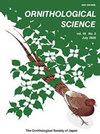乌鸦的警戒和飞行起始距离与扑杀方法、射击或诱捕的关系
IF 0.3
4区 生物学
Q4 ORNITHOLOGY
引用次数: 7
摘要
在日本,每年都有大量的大喙鸦(Corvus macrorhynchos)和腐肉鸦(Carrion Crows C. corone)被捕杀,但这种捕杀对乌鸦行为的影响从未被评估过。我假设,在一个乌鸦被射杀的地方,它们会比在它们被困住的地方对人类的干扰更敏感。2004年3月,我比较了日本岩手县附近两个不同地区乌鸦的警觉距离和起飞距离。2003年在大东地区被捕杀的1025只乌鸦全部被射杀,而在托诺地区被捕杀的1586只乌鸦中有95.3%被捕获。两个地区的地形、土地利用和人口密度相似。使用广义线性模型进行的分析表明,面积(以及因此选择的方法)是最佳模型中唯一的解释变量,并且包含在两个距离测量的前五个模型中。射击处乌鸦的警戒距离和飞行起始距离中值大于被困处乌鸦的警戒距离中值(分别为60.0 m vs. 20.5 m和46.0 m vs. 18.0 m)。其他因素,如物种、鸟群大小、行为和栖息地类型,则远没有那么重要。这些结果表明,射击对乌鸦的非致命效果比诱捕更大。虽然诱捕可能是一种比射击更有效的清除乌鸦的方法,但射击不仅直接减少了讨厌的动物的数量,而且还影响了它们的行为和栖息地的使用,从而间接减少了损害。因此,为了减少乌鸦造成的伤害,射击是更有效的选择。本文章由计算机程序翻译,如有差异,请以英文原文为准。
Alert and Flight Initiation Distances of Crows in Relation to the Culling Method, Shooting or Trapping
Abstract A large number of Large-billed Crows Corvus macrorhynchos and Carrion Crows C. corone are culled annually either by shooting or trapping in Japan, but the effects of such culling on crow behaviour have never been evaluated. I hypothesized that in an area where crows are shot they would become more sensitive to human disturbance than those in an area where they are trapped. I compared alert and flight initiation distances of crows in two nearby, but separate, areas in Iwate Prefecture, Japan, in March 2004. In 2003 all 1,025 crows culled in the Daito area were shot, whereas 95.3% of 1,586 crows culled in the Tono area were trapped. Topography, land use, and human population densities were similar in the two areas. Analyses using generalized linear models showed that the area (and hence the method of culling) was the sole explanatory variable in the best model and included in each of the top five models for both distance measures. The median alert distance and flight initiation distance were greater where crows were shot than where they were trapped (60.0 m vs. 20.5 m and 46.0 m vs. 18.0 m, respectively). Other factors, such as species, flock size, behaviour, and habitat type, were far less important. These results show that shooting has a greater non-lethal effect on crows than trapping. While trapping may be a more efficient way of removing crows than shooting, shooting not only reduces the number of nuisance animals directly, but also affects their behaviour and habitat use so that damage is reduced indirectly. Shooting is thus the more effective choice for culling in order to reduce damage caused by crows.
求助全文
通过发布文献求助,成功后即可免费获取论文全文。
去求助
来源期刊

Ornithological Science
ORNITHOLOGY-
CiteScore
1.20
自引率
0.00%
发文量
26
审稿时长
>12 weeks
期刊介绍:
Ornithological Science publishes reviews, original articles, short communications and comments covering all aspects of ornithology. Manuscripts are judged on the basis of their contribution of original data and ideas or interpretation. All articles are peer-reviewed by at least two researchers expert in the field of the submitted paper. Manuscript are edited where necessary for clarify and economy. Ornithological Science aims to publish as rapidly as is consistent with the requirements of peer-review and normal publishing constraints.
 求助内容:
求助内容: 应助结果提醒方式:
应助结果提醒方式:


